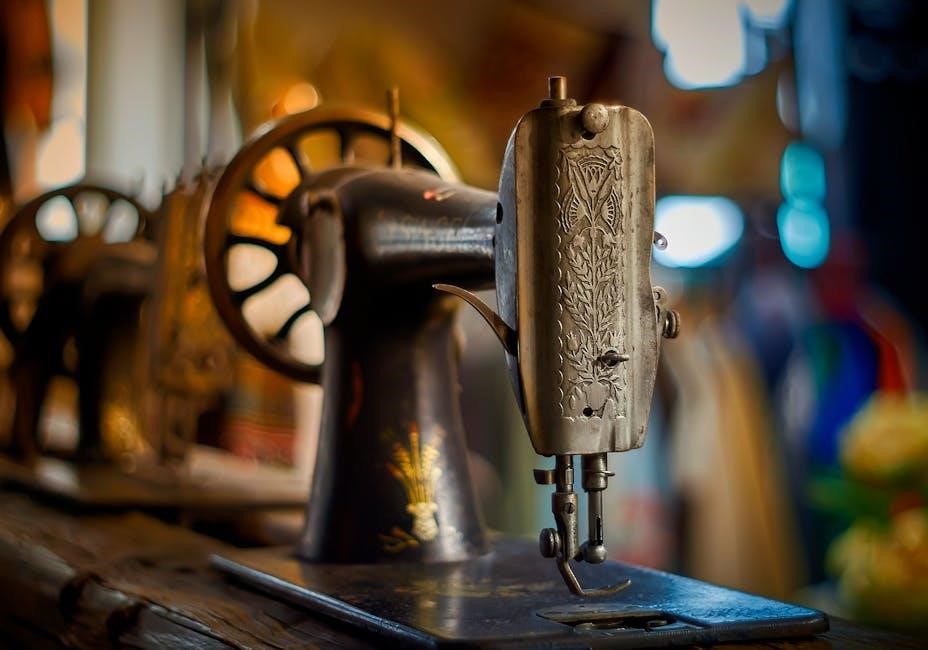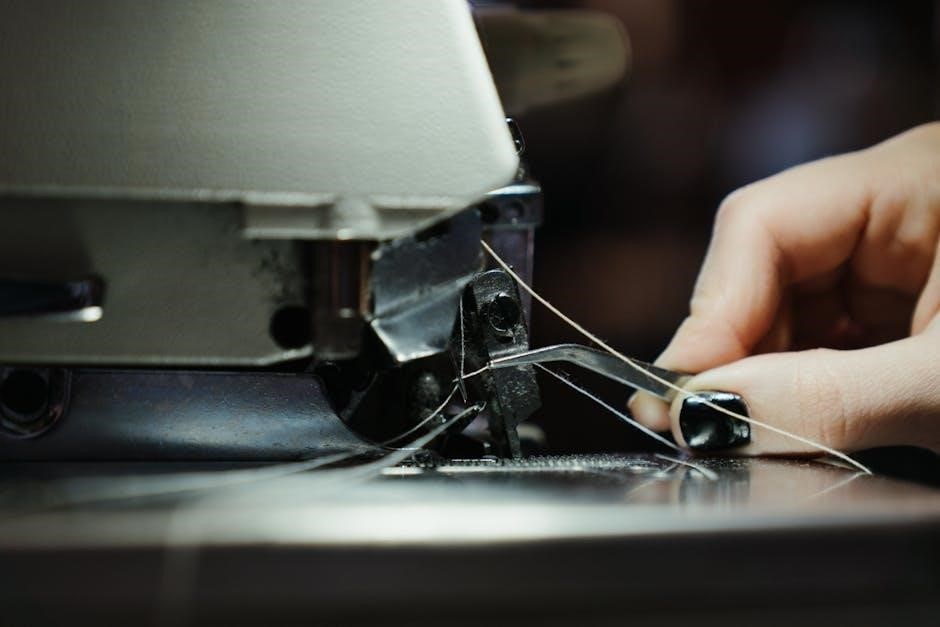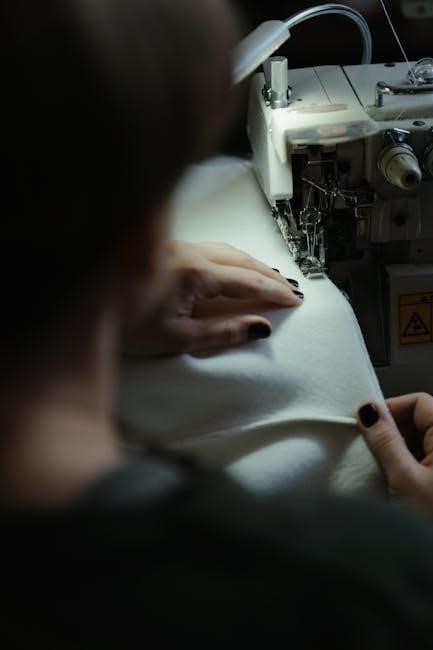manual for kenmore sewing machine 385
Summary
Access the Kenmore 385 sewing machine manual for free. Learn troubleshooting, maintenance, and get the most out of your machine.

Welcome to the Kenmore Sewing Machine 385 Manual, your comprehensive guide to unlocking the full potential of your sewing machine. This manual provides detailed instructions for setup, operation, maintenance, and troubleshooting, ensuring optimal performance and longevity.
Overview of the Kenmore Sewing Machine 385
The Kenmore Sewing Machine 385 is a versatile and reliable appliance designed for a wide range of sewing tasks. Known for its durability and ease of use, this machine is suitable for both beginners and experienced sewists. It features a sturdy build and essential functionalities that make it ideal for everyday sewing projects. The machine supports various stitch types and comes with accessories that enhance its capabilities. The manual provides detailed guidance on threading, bobbin setup, and stitch selection, ensuring users can optimize their sewing experience. Additionally, it includes safety guidelines and maintenance tips to prolong the machine’s lifespan. Whether for repairs, crafts, or heavy-duty sewing, the Kenmore 385 is a dependable choice.
Importance of Using the Manual for Optimal Performance
The Kenmore Sewing Machine 385 manual is essential for achieving optimal performance and ensuring longevity. It provides detailed instructions for threading, bobbin winding, and stitch selection, helping users master the machine’s features. The manual also covers troubleshooting common issues like thread breakage and jamming, offering practical solutions. By following the maintenance tips and safety guidelines outlined, users can prevent errors and extend the machine’s lifespan. Proper use of the manual ensures that all functions are utilized correctly, enhancing the overall sewing experience. It is crucial to refer to the manual regularly to avoid mistakes and maintain the machine in prime condition.

Model Overview and Features
The Kenmore Sewing Machine 385 is a versatile and reliable device designed for various sewing tasks. It features a sturdy build and durable materials, ensuring long-lasting performance and versatility for different fabric types and projects.
Key Features of the Kenmore Sewing Machine 385
The Kenmore Sewing Machine 385 boasts an array of features that make it a versatile tool for sewing enthusiasts. It includes multiple stitch options, such as straight and zigzag stitches, allowing for diverse sewing projects. The machine also features adjustable stitch length and width, enabling precise control over your work. A free-arm design provides easy access for sewing cuffs and sleeves, while the built-in needle threader simplifies the threading process. Additionally, the machine is compatible with various presser feet, expanding its functionality for specialized tasks like buttonhole sewing or zipper installation. These features, combined with its durable construction, make the Kenmore 385 a reliable choice for both beginners and experienced sewers.
Technical Specifications and Capabilities
The Kenmore Sewing Machine 385 is a mechanically operated device designed for versatility and reliability. It features a robust construction with durable materials, ensuring long-lasting performance. The machine offers 18 built-in stitch options, including straight, zigzag, and decorative stitches, with adjustable stitch length and width. It operates at a maximum sewing speed of 800 stitches per minute, making it suitable for both lightweight and medium-weight fabrics. The machine weighs approximately 16 pounds, providing stability during operation. It is compatible with low-shank presser feet, allowing for a variety of attachments to enhance functionality. These specifications make the Kenmore 385 an ideal choice for sewers seeking a dependable machine for everyday projects.

Identifying Parts of the Kenmore Sewing Machine 385
Understanding the machine’s components is essential for proper operation. Key parts include the spool pins, bobbin winder, stitch selector, and tension dials, all vital for seamless sewing.
Major Components and Their Functions
The Kenmore Sewing Machine 385 features several key components designed to enhance sewing efficiency. The spool pins hold the thread in place, while the bobbin winder ensures proper thread storage. The stitch selector allows users to choose from various stitch patterns, and the tension dials regulate thread tightness for consistent stitching. Additionally, the presser foot secures fabric, and the feed dogs guide material smoothly. Understanding these components is crucial for optimal machine performance and troubleshooting. Each part plays a vital role in ensuring precise and professional results. Familiarizing yourself with these elements will help you operate the machine confidently and maintain its longevity.
Locating the Model Number and Serial Number
The Kenmore Sewing Machine 385 model number and serial number are essential for maintenance, repairs, and accessing resources. These details are typically found on a small metal plate, known as the nomenclature plate, located on the back or bottom of the machine. The model number is usually preceded by “Model No.” and followed by a series of numbers, such as 385.17628. The serial number is listed nearby, often starting with a combination of letters and numbers. It is important to record these numbers for future reference, as they are required for ordering parts, downloading the manual, or contacting customer support. Always keep this information handy to ensure smooth operation and servicing of your sewing machine.

Threading and Bobbin Setup
Proper threading and bobbin setup are crucial for smooth operation. Use high-quality thread and follow the manual’s guide for correct tension and winding techniques to ensure optimal stitching.
Step-by-Step Guide to Threading the Machine
To thread your Kenmore Sewing Machine 385, start by turning off and unplugging the machine for safety. Locate the spool pin and draw the thread through the guide. Follow the diagram on the machine or manual for the correct path. Insert the thread into the tension discs and pull gently to seat it. Pass the thread through the take-up lever and then through the needle’s eye from front to back. Leave a small tail and trim excess thread. Always use high-quality, compatible thread to ensure smooth operation. Proper threading is essential for consistent stitching and prevents tangling or uneven fabric feed. Refer to the manual for specific diagrams to avoid mistakes.
Proper Bobbin Winding Techniques
For optimal performance, wind the bobbin correctly using your Kenmore Sewing Machine 385. Start by inserting the bobbin onto the winding pin and secure it firmly. Thread the end of the thread through the bobbin’s hole and pull gently to anchor it. Engage the bobbin winding mechanism, usually located on the top or side of the machine, and start winding slowly. Keep the thread taut but not overly tight to avoid uneven winding. Stop when the bobbin is about 80% full to prevent overfilling. Cut the thread, leaving a small tail, and remove the bobbin. Always use the same type of thread for the bobbin as the top thread to ensure balanced stitching. Consult your manual for specific diagrams or instructions if unsure.

Stitch Selection and Operation
The Kenmore Sewing Machine 385 offers various stitches for different fabrics. Select the appropriate stitch, adjust settings, and use proper techniques for ideal results.
Understanding Different Stitch Types
The Kenmore Sewing Machine 385 offers a variety of stitch types to suit different sewing needs. These include straight stitches for basic sewing, zigzag stitches for stretchy fabrics, and decorative stitches for embellishments; Each stitch type is designed to handle specific materials and ensure professional-looking results. The machine also features adjustable stitch length and width, allowing customization for various projects. Proper stitch selection is crucial for achieving the desired outcome, whether you’re working on clothing, home decor, or repairs. Always refer to the manual for detailed illustrations and guidance on selecting the right stitch for your fabric type and sewing task.
Adjusting Tension for Perfect Stitches
Proper tension adjustment is essential for achieving perfect stitches on your Kenmore Sewing Machine 385. Begin by ensuring both the upper and bobbin threads are evenly tensioned. The machine features adjustable tension dials that allow you to fine-tune the thread’s tightness. For most fabrics, the default settings work well, but you may need to adjust them for heavier or lighter materials. Always test your stitches on a scrap piece of fabric before starting your project. If the stitches are uneven or puckering, slightly tighten or loosen the tension dials accordingly. Refer to the manual for specific guidance on identifying and correcting tension issues for optimal sewing results.

Maintenance and Care
Regular cleaning, lubrication, and inspection are crucial for the Kenmore Sewing Machine 385. Always unplug the machine before performing any maintenance to ensure safety. Clean dust and debris from the interior, oil moving parts, and check for worn components. Proper care extends the machine’s lifespan and ensures smooth operation. Refer to the manual for detailed maintenance schedules and procedures.
Cleaning and Lubricating the Machine
Cleaning and lubricating the Kenmore Sewing Machine 385 are essential for maintaining its performance. Begin by unplugging the machine to ensure safety. Use a soft brush or compressed air to remove lint and debris from the interior, paying attention to the bobbin area and tension discs. Lubricate moving parts with high-quality sewing machine oil, following the manual’s guidelines to avoid over-oiling. Regular cleaning prevents dust buildup and ensures smooth operation. Always refer to the manual for specific instructions on lubrication points and frequency. Proper maintenance will extend the machine’s lifespan and keep it running efficiently for years to come.
Regular Maintenance Tips for Longevity
Regular maintenance is crucial to ensure the Kenmore Sewing Machine 385 operates smoothly and lasts for years. Always unplug the machine before cleaning or servicing. Check the belt for wear and tear, and replace it if necessary. Inspect the power cord for damage and ensure all connections are secure. Store the machine in a dry, cool place to prevent rust and moisture damage. Use a dust cover when not in use to protect it from dust accumulation. Additionally, refer to the manual for recommended maintenance schedules and procedures. By following these tips, you can extend the lifespan of your Kenmore Sewing Machine 385 and maintain its performance.

Troubleshooting Common Issues
Identify and resolve common issues like thread breakage or machine jamming by checking thread tension, cleaning lint, and rethreading. Consult the manual for detailed solutions.
Diagnosing and Solving Thread Breakage
Thread breakage is a common issue that can disrupt your sewing workflow. To diagnose the problem, start by checking the thread tension, as incorrect settings can cause frequent breaks. Ensure the thread is properly seated in the tension discs and that the bobbin is correctly inserted. If the thread is tangled or knotted, gently remove it and rethread the machine. Regularly clean lint and debris from the machine, as buildup can lead to thread breakage. Consult the manual for specific guidance on adjusting tension and rethreading. By addressing these factors, you can resolve thread breakage and maintain smooth sewing operation.
Fixing Jamming or Uneven Stitching
Jamming or uneven stitching can be frustrating, but these issues are often easy to resolve. Start by turning off the machine and removing any tangled thread or fabric. Check for lint or debris inside the machine, especially around the bobbin area, and clean it thoroughly. Ensure the bobbin is correctly seated and the thread is properly threaded through the tension discs. Uneven stitching may result from incorrect tension settings—adjust the upper and bobbin tension to achieve a balanced stitch. If the issue persists, consult the manual for guidance on resetting the machine or lubricating moving parts. Regular maintenance and proper thread management can prevent future jams and ensure consistent stitching quality.

Accessories and Attachments
Enhance your sewing experience with compatible presser feet and optional accessories. Use zigzag, buttonhole, or zipper feet for specialized tasks. Explore extension tables and embroidery attachments for expanded creativity.
Compatible Presser Feet and Their Uses
The Kenmore Sewing Machine 385 supports a variety of presser feet, each designed for specific sewing tasks. The zigzag foot is ideal for general sewing and zigzag stitches, while the zipper foot is perfect for installing zippers and sewing close to厚 materials. The buttonhole foot simplifies creating precise buttonholes, and the blind hem foot is great for sewing invisible hems on pants and curtains. Additional feet, like the walking foot, help manage thick fabrics or multiple layers. These accessories enhance versatility and precision, allowing you to tackle a wide range of projects; Always refer to the manual for compatibility and installation guidance.
Optional Accessories for Enhanced Sewing
Enhance your sewing experience with optional accessories designed for the Kenmore Sewing Machine 385. A walking foot is ideal for managing thick fabrics or multiple layers, ensuring smooth stitching. The quilting foot provides a larger surface area, perfect for handling large quilting projects. An embroidery hoop allows for decorative stitching and intricate designs. Additionally, a carrying case offers convenient storage and transport of your machine. Other accessories include an extension table for managing bulky fabrics, specialized presser feet for unique tasks, and replacement needles and bobbins. These optional additions expand the machine’s versatility, enabling you to tackle a wider variety of sewing projects with precision and ease. Always ensure accessories are compatible with your model for optimal performance.

Safety Precautions
Always unplug the machine before cleaning or adjusting parts. Avoid loose clothing or long jewelry near moving components. Keep children away during operation. Use the correct needle size to prevent breakage. Never touch hot or sharp parts. Ensure proper ventilation and avoid overloading the machine. Follow all guidelines in the manual to ensure safe and efficient sewing experiences.
Essential Safety Guidelines for Operation
Always unplug the Kenmore Sewing Machine 385 before cleaning, lubricating, or making adjustments to avoid electrical hazards. Wear protective eyewear and avoid loose clothing or jewelry that could get caught in moving parts. Keep children and pets away while operating the machine. Use the correct needle size and type for your fabric to prevent breakage and potential injury. Ensure the work area is well-lit and free from clutter. Never touch sharp edges or hot components. Follow the manual’s guidelines for threading and stitch selection to maintain control. Regularly inspect the machine for damage and ensure all parts are securely tightened. By adhering to these guidelines, you can enjoy safe and efficient sewing experiences.
Preventive Measures to Avoid Accidents
To ensure safe operation of the Kenmore Sewing Machine 385, take preventive measures to avoid accidents. Regularly inspect the machine for worn or damaged parts, such as needles or belts, and replace them immediately. Always use the correct needle type and size for your fabric to prevent breakage. Keep sharp objects like scissors and pins away from children. Store the machine in a stable, dry place to avoid tipping or electrical issues. Avoid overloading the machine with thick fabrics, as this can cause mechanical stress. Never leave the machine unattended while in use, and ensure all accessories are securely attached. By following these preventive steps, you can minimize risks and enjoy a safe sewing experience.
Downloading and Referencing the Manual
The Kenmore Sewing Machine 385 manual is available for download online in PDF format. Access it through trusted sources like the official Sears website or authorized sewing communities. Ensure the manual is compatible with your machine’s model number for accurate information. Print or save the document for easy reference during setup, operation, or troubleshooting. Regularly update your downloaded copy to have the latest guidelines and safety precautions. By downloading and referencing the manual, you can optimize your sewing experience and maintain your machine effectively.
Where to Find the Kenmore 385 Manual Online
To locate the Kenmore Sewing Machine 385 manual online, visit trusted resources like the Sears PartsDirect website or ManualsLib. These platforms offer free PDF downloads of the manual, ensuring easy access to instructions for your specific model. Additionally, sewing communities and forums like Sewing Parts Online or Quora often share links to user manuals. Always verify the source to ensure you download the correct and most recent version of the Kenmore 385 manual for accurate guidance on operation, maintenance, and troubleshooting.
How to Use the Manual Effectively
To maximize the benefits of the Kenmore Sewing Machine 385 manual, start by thoroughly reviewing the table of contents to familiarize yourself with its structure. Begin with the safety precautions and basic operation sections to ensure safe handling. Pay attention to diagrams and illustrations, which provide visual guidance for threading, bobbin setup, and stitch selection. Refer to the troubleshooting section for quick solutions to common issues like thread breakage or jamming. For maintenance, follow the step-by-step cleaning and lubrication instructions to preserve the machine’s performance. By systematically exploring each section, you can efficiently utilize the manual to enhance your sewing skills and maintain your machine’s optimal functionality over time.